How a giant became a dwarf: C-124 Globemaster II from Roden
The challenge of depicting such a huge aircraft as the Globemaster II on such a small scale as 1:144 is particularly fascinating for me. But the question of whether one could credibly represent the really big in the really small was only one, albeit powerful, impulse to reach for this kit.
Another and of course no less important incentive came from the fascinating shape of this transport plane, a third from the exciting history in which the story of the Globemaster is embedded. These two points I would also like to mention at the very beginning of my report.
The importance of transport aircraft capacity for global armed forces was illustrated by the years of the Second World War. The sometimes unprecedented strategic situations brought about by the spread of the Cold War meant that the value of potentially expanded air transport continued to rise after 1945. The "Berlin Airlift" in 1948/49 ultimately became a symbol of the eminent value of a powerful and therefore sustainable air transport fleet.
Based on these insights and experiences, new concepts of large-capacity transport were explored in the late 1940s. The Douglas C-124 Globemaster II, first flown in 1949, was a particularly successful result of these efforts.
One example of the innovative spirit of those days was a hydraulically lowerable loading ramp at the bow and two heavy-duty cranes, each weighing 3800 kilograms, which could be used to load the side cargo doors. The C-124 was able to carry an impressive 31,100 kilograms of cargo to the maximum in the air; this required four Pratt & Wittney R-4360 engines, each producing 3800 hp.
Other characteristics also give an idea of what an impressive giant the Globemaster II must have been: over 53 metres of wingspan, with a length of 39.75 metres, the maximum weight of the machine is 88.2 tonnes.
In the years and decades that followed, the Globemaster II was used wherever the US armed forces had to land material on a large scale: the C-124 flew in the Korean War and ten years later in or after Vietnam. At these and other locations where the US military was operating, the C-124 made a significant contribution to the logistical link with the US homeland.
During the Cold War, however, the Globemaster fleet was also used for a specific task that initially only it was capable of: thanks to its dimensions, it could pick up and transport the Thor medium-range ballistic missile in one piece in its cargo hold.
From 1970 onwards, the remaining machines were passed on to the ANG, although the last C-124 Globemaster II was to be decommissioned as early as 1974. A total of 448 units were built and delivered to the US Air Force.
My specimen shows a C-124A of the 3rd Strategic Support Squadron, which with its striking color scheme may well be one of the most attractive Globemaster II. As a reference I was able to use the high quality footage of the 50's movie "Strategic Air Command", which offers first class footage for an interesting range of aircraft. The flight and ground shots of the B-36 Peacemaker or the B-47 Stratojet in this film are not without reason legend. I can warmly recommend this film to anyone who is enthusiastic about such aircraft!
Another nice thing about it is that James Stewart is not only one of the most remarkable actor personalities of the US film, but also a former USAAF bomber pilot who knows what he is talking about.
But back to the model: the decals are from Caracal. I can recommend them for two reasons: on the one hand, they are easy to work with, are made with quality and offer the choice of after all eleven attractive versions of the Globemaster in US Air Force and ANG markings, on the other hand, this also solves the misery with the decals from Roden. I would like to put it in a short formula and not explain it further: the decals included in the kit are simply not usable.
The verdict on the kit parts is milder. Accuracy of fit and formal coherence are good, necessary filling and sanding work is within the limits of what one can expect from a "short run" upscale kit.
A striking exception, however, is the engine nacelles, whose glued-together raw form has a gap of several millimetres in width that causes displeasure. But I don't want to exclude the possibility that the fault lies with me and that a more level-headed model builder would have managed a smooth collapse of the parts. But at least this part of the construction has to be called "tricky", it requires special care and in my case a lot of filler material.
The exterior of the model was completed with homemade antennas and wiring of the undercarriage; the main part of my detailing was done by the paint job, though.
Machines like the C-124 with its typical NMF-painting are a nice playground for trying out metal colours. As almost always in such a case, I resorted to the Alclad II range. In several work steps, alternating masking and spraying was used to imitate a metal skin as diverse as possible, close to the original. The orange of the "Dayglow" is from Gunze.
In conclusion I may say that I personally enjoyed this construction very much and consider the result as a certainly not "perfect" but for me successful approach to the varied appearance of a metal skin on a large surface.
Is it possible to credibly represent the really big in the really small? I do not know, but the 144 scale will see me again!
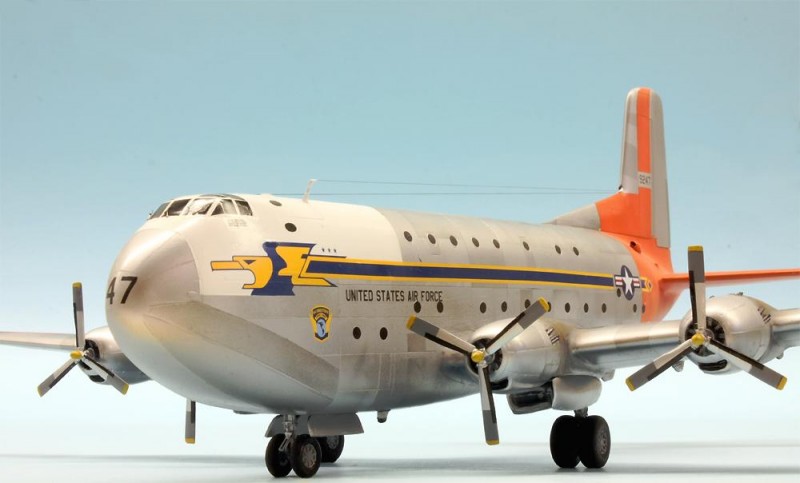
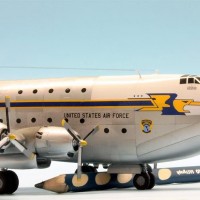
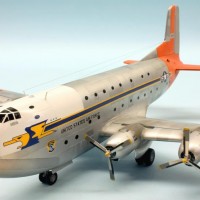

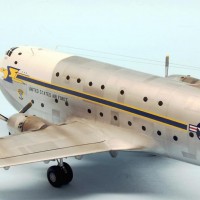
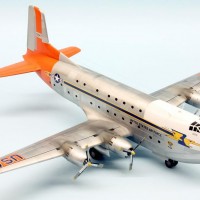

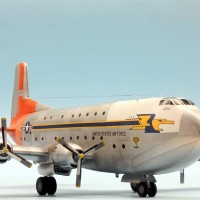
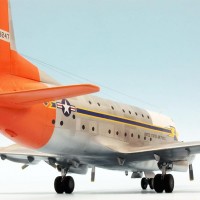
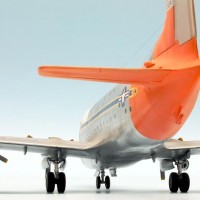
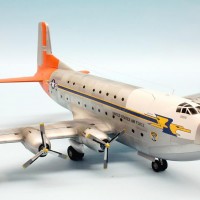
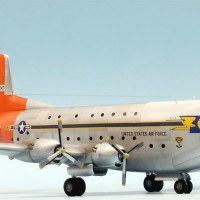
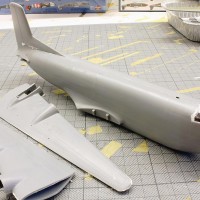
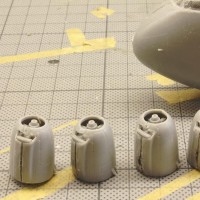
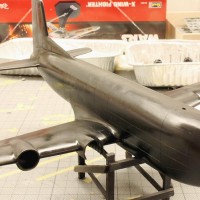
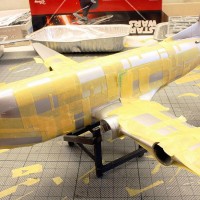
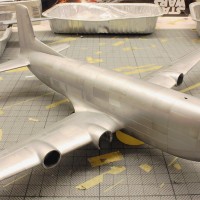

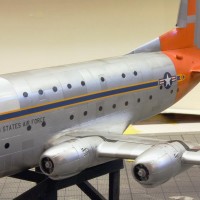
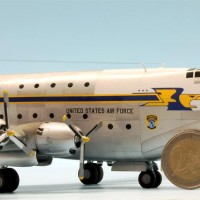
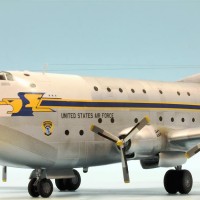
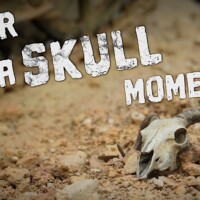
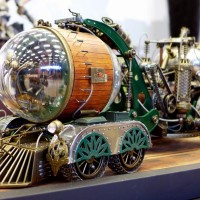
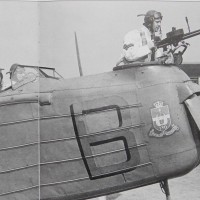
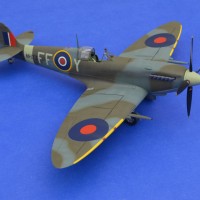
Hard to believe the scale Roland. Overall paint work is marvelous, kicking the model to a much bigger scale in these photos. Very eye catching scheme indeed
Excellent work of a seemingly difficult kit, Roland. You did a wonderful job of putting it together, eliminating the imperfections and finishig with spectacular painting/decalling/weathering.
1/144 looks a great scale for planes like this.
Congratulations!
Well done Roland, she really does look big even in that scale. Really enjoyed the comment about the fit of the engine nacelles causing displeasure. I know the feeling.
Like the busy look of the finish. Can't go wrong with day glow.
A-#1 model.
In the 1950's I got to do a "Walk-Through" of this and a few other big cargo airplanes at the "Akron-Canton, Ohio" air terminal. Great model you made and thanks for sharing your "excellent photos." Rodney.
Beautiful work, on a really impressive plane. I was fortunate enough during the 1970's to explore and play in one of these planes at the SAC Museum at Offutt, AFB in Bellevue, Nebraska. It is hard to imagine a plane of that size and weight ever getting off the ground with just those four engines, no matter how big they are. The fuselage is mammoth and was so much fun to play around in, the cockpit is really way up in the air when you sit in the cockpit you realize just how far off the ground you are, more than a 3 story building! Again excellent work and painting.
I wonder if the pilot got surprised when he realized that moment of touchdown was always a bit earlier than anticipated.
That is a high quality build
Original and fantastic. Bravo!
As someone unfortunate enough to have been a passenger on "Old Shakey" once while hitchiking back from leave, this model brings back some memories. That airplane really deserved the nickname! And (as usual) one engine gave out halfway between Lowry AFB and Norton AFB. The shaking got worse with the asymmetric power.
However. This is a really nice model Roland, fully up to the standards one comes to expect from you. Excellent work on the metal finish and from the in-progress shots definitely a triumph of talent and skill over plastic.
That is a sweet paint job!
Beautifully done!
First class modeling, superb painting/masking and windshield wipers in 1/144th. Impressive! Wow, a LOT of Tamiya tape was harmed in making this. 😉
Looks good Roland, nicely detailed, well done.
Thanks for sharing your insights on the build. The kit is on my workbench as well, including Caracal decals. You show a striking result, I will take it as a reference ;-)!
Some great forced perspective shots with close ups combined with a good choice of panels to paint with a off shaded of silver makes for some good eye candy. The detail on the props is impressive given the scale and the paint scheme is attractive or easy on the eyes.
I like it. Two thumbs up Roland.
Thank you all for this interested, friendly and very motivating feedback!
I am so impressed with the personal experiences you were able to make with the Globemaster! As always a special thanks to Tom Cleaver; your experience with airplanes is once again more than impressive. Thanks for sharing all this!
All the best with these ingredients, Thomas! 🙂
Excellent work! Love the paint job and finish on it.
Thank you Greg, you are motivating me again!